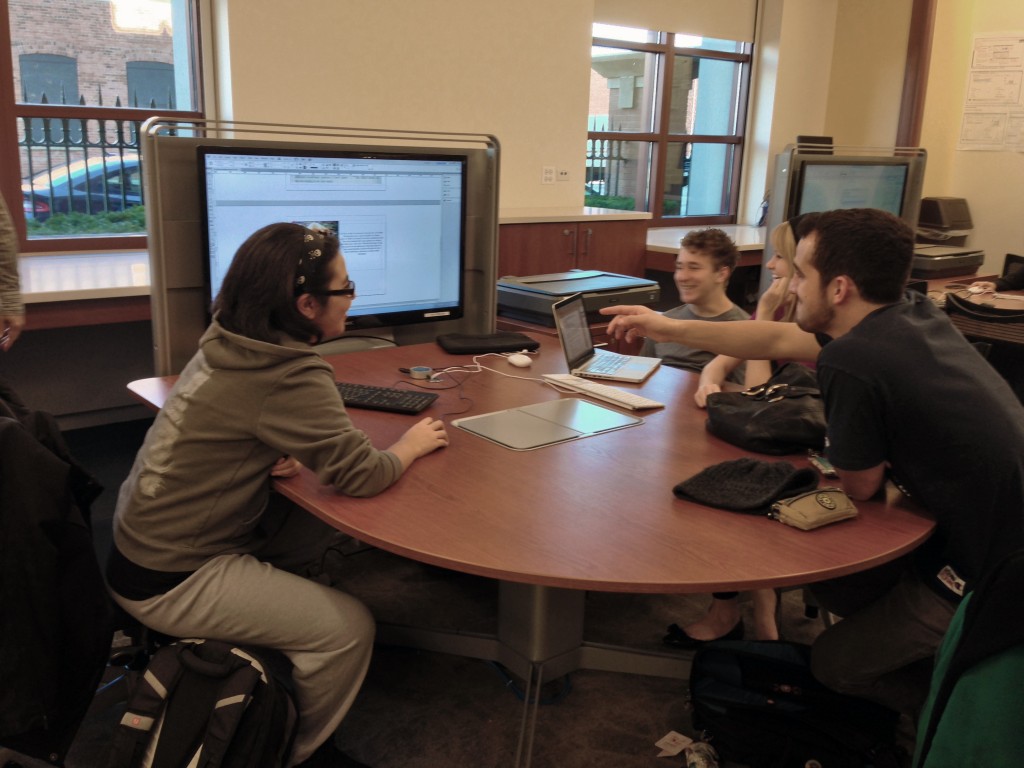The Department of English Digital Humanists Will Present at the Chicago Colloquium on Digital Humanities and Computer Science
The 8th Annual Chicago Colloquium on Digital Humanities and Computer Science will take place December 5-7, 2013, on the Lincoln Park Campus of DePaul University. The conference will consist of a plenary address by a significant Digital Humanist, as well as panels, roundtables, or other kinds of sessions proposed by scholars relating to recent issues and advances in the digital humanities.
Professor John Shanahan and GA Josh Fisher will be presenting at the conference. Prof. Shanahan will be sitting on a panel of speakers discussing pedagogic application of digital humanities. Josh will be presenting his GPS-enabled arts and literature magazine entitled Infused.
Registration for the event is available for free here.
English Majors in the Lab: Expanding the History of Books to Digital Formats
 Prof. Shanahan and Megan Bernal will explain, and evaluate, their team-‐taught fall 2013 Capstone course for English majors “Literature in the Age of Intelligent Machines.” Their course was the first to make use of a new Scholar’s Lab at DePaul created to facilitate hands–‐on digital humanities projects. They will report their experiences teaching English majors with little or no experience of software applications how to research, develop, and archive digital literary projects and their associated metadata. They will discuss their course goals, and the actual results, as well as its overall fit with current best practices for the creation, access, and retention of ‘born digital’ materials. Among their presentation sub-‐topics will be reflections on the proper mixture of lab time at the bench and online tutorials, office hours, and face-‐to-‐face classroom discussion; choice of literary objects and archiving formats; challenges of teaching advanced software programs to humanities students; technology and personnel needs.
Prof. Shanahan and Megan Bernal will explain, and evaluate, their team-‐taught fall 2013 Capstone course for English majors “Literature in the Age of Intelligent Machines.” Their course was the first to make use of a new Scholar’s Lab at DePaul created to facilitate hands–‐on digital humanities projects. They will report their experiences teaching English majors with little or no experience of software applications how to research, develop, and archive digital literary projects and their associated metadata. They will discuss their course goals, and the actual results, as well as its overall fit with current best practices for the creation, access, and retention of ‘born digital’ materials. Among their presentation sub-‐topics will be reflections on the proper mixture of lab time at the bench and online tutorials, office hours, and face-‐to-‐face classroom discussion; choice of literary objects and archiving formats; challenges of teaching advanced software programs to humanities students; technology and personnel needs.
GPS-Enabled Stories and the Quantification of Creative Density
![]() Josh Fisher will present a new mobile app for interactive story creation and reception. Over the past six months he has been leading the development of a mobile application called “Infused” that lets a user drop physical hotspots for stories, music, and art on a Google map. When a user of the application walks through one of these hotspots, his or her phone vibrates, and he or she will be able to read, listen, or watch content left by a previous contributor-visitor. For example, one could place a text or other object associated with Little Red Riding Hood on the Lake Shore running/biking Path. When a person with my app walks by the Little Red Riding Hood hotspot, the phone will vibrate and he or she be able to engage with the story on the trail. This augmented reality technology allows the blending of the physical and digital worlds to create a new way to engage with narrative.
Josh Fisher will present a new mobile app for interactive story creation and reception. Over the past six months he has been leading the development of a mobile application called “Infused” that lets a user drop physical hotspots for stories, music, and art on a Google map. When a user of the application walks through one of these hotspots, his or her phone vibrates, and he or she will be able to read, listen, or watch content left by a previous contributor-visitor. For example, one could place a text or other object associated with Little Red Riding Hood on the Lake Shore running/biking Path. When a person with my app walks by the Little Red Riding Hood hotspot, the phone will vibrate and he or she be able to engage with the story on the trail. This augmented reality technology allows the blending of the physical and digital worlds to create a new way to engage with narrative.
He will also explain how the app has potential uses beyond mobile narrative. Because the “Infused” application records latitude and longitude coordinates, content type, genre information, and subject matter (the information is kept in a server-side database accessed by the application’s content management system), it is possible to track through accumulated use what he would call the “creative density” of a community, neighborhood, or region. His project aims to quantify and track the density of creative content in communities in relation to inspiring events. Linking to other big data work in DH, I expect my app will confirm that communities will exhibit varied densities of subject matter, genre, and media type dependent upon demographics and location.
